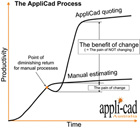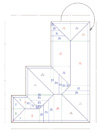Advanced Roofing Software Increases Productivity
In recent times we have seen huge improvements in the software that assists contractors with determining roofing material quantities. New products are easier to use and more affordable. Computer performance has improved and hardware costs have been reduced. As a result, a complete roofing take-off system, which can significantly increase productivity, is available at a cost that is insignificant when compared to the salary of a surveyor or estimator. A company that wants to compete successfully in today’s market simply cannot afford to be without a state-of-the-art job quoting program.

In recent times we have seen huge improvements in the software that assists contractors with determining roofing material quantities. New products are easier to use and more affordable. Computer performance has improved and hardware costs have been reduced. As a result, a complete roofing take-off system, which can significantly increase productivity, is available at a cost that is insignificant when compared to the salary of a surveyor or estimator. A company that wants to compete successfully in today’s market simply cannot afford to be without a state-of-the-art job quoting program.
Enter technology! Making the change, however, does have a small negative impact that is quantifiable, and we might refer to this as “the pain of change.” That is, things get worse before they get better. Management must understand this and budget for it as part of the cost of implementation. On the up side, of course, is the benefit of change (or indeed, the pain of not changing). The graph in Figure 1 illustrates the point very well. In our experience, productivity improvements of four or five times are quite usual. Instead of doing one or two estimates a day, estimators can complete five or six a day with today’s software and a complete job document trail is available at the click of a mouse.

Once the model of the roof is complete, the real advantages of this process become apparent. There are built-in tools to check that the model is correct. The model may be viewed from any point of view (because it is a true 3-D model of the roof), plus the model may be fully dimensioned automatically, with overall measurements and up-the-slope measurements. These checks ensure that when the quotation is complete, you know it is correct.
Roof cover material and accessories are selected from a built-in database and a simulation of the application of these materials is completed, from which a detailed materials list and quotation is produced. When entry is complete, the estimator can generate a variety of reports, work orders and drawings to suit the company’s needs.
A customizable database associates the pertinent details and accessories with each material type. This information is then used in selecting the material for a particular project. The software generates a detailed material list that gives the exact quantities of each panel length (for a metal roof) and tile quantities (determined by course) for a project and all accessories. Material and labor costs are also calculated from this information.
Today’s advanced software can produce fully rendered, color-specific 3-D drawings showing exactly how the new roof will look. The user can easily check that the computer model is correct by viewing the roof at different angles. This also makes a great sales presentation tool because it lets the client see the actual roof color on the model.

• Ease of use. An estimator will be more productive if the software is easy to learn with user-friendly commands. A complex interface can be confusing, especially for part-time users. For power users, a well-organized interface will enhance productivity. A comprehensive Help menu and a description of each icon will speed the learning process immensely. The software should be flexible, enabling the user to extract only what he or she wants out of the system.
• Automatic detailing. For the most part, programs available today have some sort of automatic detailing built in. The user should be able to turn automatic detailing on or off as needed. The estimator should easily be able to recognize what flashings are applied to what areas simply by looking at the drawing.
• Sheet layout. A sheet placement drawing to help with roof installation should be produced automatically. The layout should show the location of each panel with its length. Try to avoid confusing codes and labels, as the installers may have trouble deciphering the codes. Also, the software should have the ability to shift the panels to the exactly location where the user wants the seam. This aids the estimator tremendously in laying out the roofing sheets exactly the way the roof will be installed, thus increasing the accuracy of the company’s bids. The more mature products in the market also have advanced waste optimization capability to fine-tune the amount of material required. Some products on the market also have tools to determine panel placement to reduce waste material by as much as 10 percent, depending upon panel profile and roof shape, with a color coded report to show how the off-cuts will be installed.
• Tiles by course. The most accurate way to determine tile quantities is to lay them on the roof model course by course, taking into account the use of special tiles such as verge tiles, step tiles, half tiles, etc., and generating a quantity list based on the actual requirement, not an approximation. The more developed programs will provide this capability and the results will benefit your business by way of reduced waste and improved profits.
• Flexibility. Does the software have the ability to keep up with the new building designs? With more and more architects moving towards metal roofing and cladding, it’s best to make sure the software has the ability to handle the complete solution.
Also, check out the support page on the vendor’s Web site. Does it have helpful information for both beginners and advanced users? Are there regularly scheduled training classes that you may attend? How often are the updates released, and what do they cost? These are just some of the questions potential buyers should be asking. Downtime is very frustrating and may also be costly to your company.

In recent times we have seen huge improvements in the software that assists contractors with determining roofing material quantities. New products are easier to use and more affordable. Computer performance has improved and hardware costs have been reduced. As a result, a complete roofing take-off system, which can significantly increase productivity, is available at a cost that is insignificant when compared to the salary of a surveyor or estimator. A company that wants to compete successfully in today’s market simply cannot afford to be without a state-of-the-art job quoting program.
The Pain of Change
All processes reach a point of diminishing returns, which basically means that, at a certain point, no matter how hard you push, you do not get any significant productivity improvement from that process. Manual estimating processes for roofing are a case in point - you reach a point where you simply cannot reliably improve the number of quotations you can do in a day.Enter technology! Making the change, however, does have a small negative impact that is quantifiable, and we might refer to this as “the pain of change.” That is, things get worse before they get better. Management must understand this and budget for it as part of the cost of implementation. On the up side, of course, is the benefit of change (or indeed, the pain of not changing). The graph in Figure 1 illustrates the point very well. In our experience, productivity improvements of four or five times are quite usual. Instead of doing one or two estimates a day, estimators can complete five or six a day with today’s software and a complete job document trail is available at the click of a mouse.

Figure 1. This chart illustrates productivity rates over time. Use of job quoting software can greatly increase productivity, but the transition period results in a short-term decrease in productivity while people adjust to the program. We might refer to this negative impact as “the pain of change,” but the benefits in this case clearly outweigh the costs over time.
Common Features
Using the new breed of products is straightforward, too. The user builds a 3-D model of a roof by entering roof perimeter dimensions and roof pitch. From this information, the software automatically determines the locations of hips, valleys and ridges and creates an accurate roof model. Once the model is complete, architectural features such as dormers, Dutch gables, etc., may be added with just a couple of mouse clicks. If the estimator is using an image from a plan service, he or she simply displays it on the screen and traces the image using a mouse.Once the model of the roof is complete, the real advantages of this process become apparent. There are built-in tools to check that the model is correct. The model may be viewed from any point of view (because it is a true 3-D model of the roof), plus the model may be fully dimensioned automatically, with overall measurements and up-the-slope measurements. These checks ensure that when the quotation is complete, you know it is correct.
Roof cover material and accessories are selected from a built-in database and a simulation of the application of these materials is completed, from which a detailed materials list and quotation is produced. When entry is complete, the estimator can generate a variety of reports, work orders and drawings to suit the company’s needs.
A customizable database associates the pertinent details and accessories with each material type. This information is then used in selecting the material for a particular project. The software generates a detailed material list that gives the exact quantities of each panel length (for a metal roof) and tile quantities (determined by course) for a project and all accessories. Material and labor costs are also calculated from this information.
Today’s advanced software can produce fully rendered, color-specific 3-D drawings showing exactly how the new roof will look. The user can easily check that the computer model is correct by viewing the roof at different angles. This also makes a great sales presentation tool because it lets the client see the actual roof color on the model.
The Benefits
What is the payoff for a roofing company? By using one of these software packages to speed up the production of estimates, an estimator can spend more time on those parts of the bidding process that cannot be helped by software, such as phoning to verify specs, doing field measurements, tracking jobs for feedback, etc. He or she will also be able to bid more jobs with greater accuracy, which usually results in more successful bids and larger profits on completed jobs. When change orders come in, producing a new estimate is a breeze. The estimator simply modifies the roof model using powerful built-in roof modeling tools and runs a new report. Finally, custom-designed report forms, full-color drawings and other computer-generated output contribute greatly to the company’s professional image.
A sheet placement drawing can show the location of each panel with its length. Applicad features roof sheet optimizer routines that reduce waste and improve efficiency on site by showing the installer how to flip sheets on the roof to save off-cut material.
Key Features
When deciding which software to buy, it is important to look for the following features:• Ease of use. An estimator will be more productive if the software is easy to learn with user-friendly commands. A complex interface can be confusing, especially for part-time users. For power users, a well-organized interface will enhance productivity. A comprehensive Help menu and a description of each icon will speed the learning process immensely. The software should be flexible, enabling the user to extract only what he or she wants out of the system.
• Automatic detailing. For the most part, programs available today have some sort of automatic detailing built in. The user should be able to turn automatic detailing on or off as needed. The estimator should easily be able to recognize what flashings are applied to what areas simply by looking at the drawing.
• Sheet layout. A sheet placement drawing to help with roof installation should be produced automatically. The layout should show the location of each panel with its length. Try to avoid confusing codes and labels, as the installers may have trouble deciphering the codes. Also, the software should have the ability to shift the panels to the exactly location where the user wants the seam. This aids the estimator tremendously in laying out the roofing sheets exactly the way the roof will be installed, thus increasing the accuracy of the company’s bids. The more mature products in the market also have advanced waste optimization capability to fine-tune the amount of material required. Some products on the market also have tools to determine panel placement to reduce waste material by as much as 10 percent, depending upon panel profile and roof shape, with a color coded report to show how the off-cuts will be installed.
• Tiles by course. The most accurate way to determine tile quantities is to lay them on the roof model course by course, taking into account the use of special tiles such as verge tiles, step tiles, half tiles, etc., and generating a quantity list based on the actual requirement, not an approximation. The more developed programs will provide this capability and the results will benefit your business by way of reduced waste and improved profits.
• Flexibility. Does the software have the ability to keep up with the new building designs? With more and more architects moving towards metal roofing and cladding, it’s best to make sure the software has the ability to handle the complete solution.
The Company
Another important consideration is the software company’s reputation and support system. Look for a vendor that stresses support for the needs of both new and existing customers and has an active program of customer feedback. Customer interaction is the best way for developers to truly understand the needs of the users. The software company should have no problem furnishing a list of half a dozen contented users of its software. Can you reach the customer support staff during your normal business hours? Sometimes support may be available through affiliate support centers in other countries, vastly extending service hours to you by offering almost 24/7 support.Also, check out the support page on the vendor’s Web site. Does it have helpful information for both beginners and advanced users? Are there regularly scheduled training classes that you may attend? How often are the updates released, and what do they cost? These are just some of the questions potential buyers should be asking. Downtime is very frustrating and may also be costly to your company.
New Technology Works
It is a fact that new technology can bring productivity benefits to a roofing company. Almost all successful businesses today use some form of computer-based accounting or business management software, and they get the benefit of timely reports of profit and loss accounts and balance sheets. With roofing software being so cost-effective, processes can be similarly automated with even greater productivity improvements, improved accuracy, reduced waste and much more professional presentation of quotations, purchase orders and roof drawings. Quotations may now be completed in minutes instead of hours and a complete set of job documentation is created for the file.Links
Looking for a reprint of this article?
From high-res PDFs to custom plaques, order your copy today!




.webp?height=200&t=1651783959&width=200)

